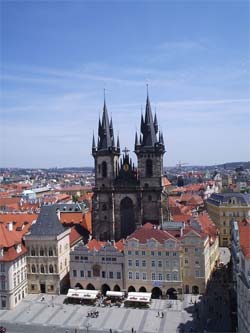
According to the conservationist, the function of houses for living should prevail even in the reservation
 |
"The Prague Heritage Reserve was inscribed on the UNESCO World Heritage List for its well-preserved historical urbanism, architecture, and also panoramic values. It is up to us to preserve this heritage for future generations," the heritage expert stated. The Prague Heritage Reserve was declared on July 21, 1971.
The concept of heritage reserves has been addressed by prominent urban planners and heritage experts in the country for nearly a century, but serious consideration and work on its preparation began only after 1945. However, the largest area reserve in Prague was not declared among the first.
As early as 1950, Prague, along with 29 other Czechoslovak cities, was declared a reserve – at that time, not only the issue of heritage protection was addressed, but especially the questions related to the post-war reconstruction of historical city cores, many of which were affected by the war or population displacement, Gája recalls. Until 1958, there was also no legislative regulation. It was only with the new heritage law of 1958 that a basis was created for the possibility of extensive heritage protection. Based on this law, reserving decrees for new urban heritage reserves were issued.
However, in the case of Prague, its final declaration was delayed until 1971. Originally, only the area of the Old Town, Josefov, and Lesser Town with Hradčany were included in the reserve in 1950. Even until the end of the 1960s, discussions were held about extensive demolition interventions in the area of the current reserve, primarily related to large transport technical solutions, such as the Malostranský Tunnel. "The unfortunate legacy of this period is still the north-south motorway. Gradually, however, a model that ensured urban protection for the historical Prague cities as a whole, in the extent given to Prague by the government of Charles IV, was established," said Gája.
According to him, the main reasons for the declaration of the reserve were the efforts to protect the architectural, urbanistic, and also panoramic values of the historical core of Prague. The area of the heritage reserve contains more than 1,360 cultural monuments and three dozen national cultural monuments. A significant part also consists of well-preserved building ensembles from the 19th and 20th centuries.
According to him, the role of the reserve is not only to protect the urban complex but also the views of the area that is part of the reserve - this is ensured by the protective zone regulation from 1981. Typically, heritage zones like Karlín or Vinohrady are designated along the perimeter of the reserve, which were declared shortly after the revolution in 1991.
"In connection with the adoption of the new building law, however, there is a risk that the role of heritage care in the protective zone will be effectively limited, as it is newly integrated into the jurisdiction of the building authority. It is thus possible that state heritage care will no longer be able to express its views on high-rise construction in the visual horizon of the PPR as it could before," Gája stated.
The Ministry for Regional Development defends the law, which has been under preparation for several years, with the argument of faster building procedures and adherence to deadlines. In response to numerous criticisms from heritage experts, it claims that heritage care in the Czech Republic will not weaken after the law is adopted.
The English translation is powered by AI tool. Switch to Czech to view the original text source.
0 comments
add comment










